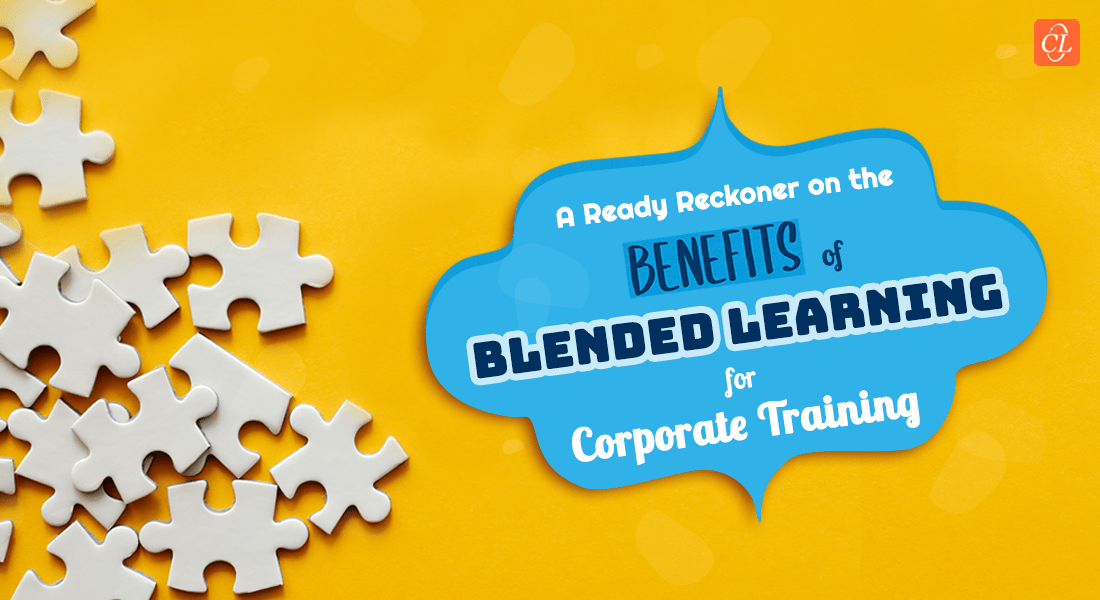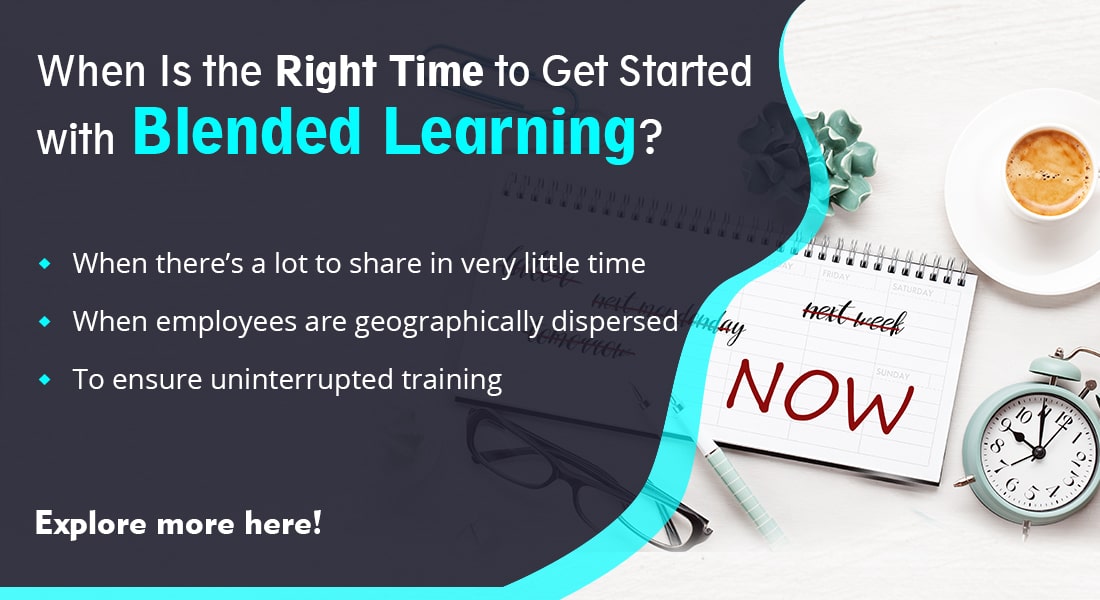Blended Learning: Why is it the Most Effective Corporate Training Solution?

It’s a fact. Learning and Development is indispensable to the infrastructure of every organization. Rapid globalization and fast changing market trends have led to the emergence of new business avenues that are driving organizations to embrace innovation and maintain their competitive edge. Consequently, the need to upskill employees and teach them about new products and services on a regular basis has become a priority. ‘Blended Learning’ seems to be the most viable training solution to cater to effective and undisturbed corporate training considering today’s remote working environment brought on by the pandemic.
Key Benefits of Blended Learning
- Enhances learner engagement
- Ensures effective learning
- Enables beating the Forgetting Curve
- Accommodates flexible learning
- Streamlines training time and cost
What is Blended Learning?
Blended Learning is a rapid eLearning solution that gives the learner the scope to use different formats to address distinct phases of learning thereby maximizing their learning experience. The blended learning approach makes learning engaging and highly immersive by offering a variety of training formats based on the training need, learners’ profiles, and the learning environment. It offers a combination of in person and virtual training environments. In person training includes classroom training and workshops and virtual training incorporates a variety of formats like VILT (Virtual Instructor-led Training), mobile learning, and microlearning.
Why Blended Learning is an Ideal Solution for Your Corporate Training Needs?
Based on the ‘Cone of Learning,’ developed by American educator, Edgar Dale, an individual’s recall is highest during active learning. This happens when
- The training is highly engaging and interactive (e.g., in a classroom) and,
- Participants are involved in activities where they get the opportunity to work through real-life situations (interactivities and simulations in an eLearning course)
Blended Learning offers the best of both worlds and is the ideal solution for your corporate training needs. It is one of the most popular choices of L&D leaders as it offers a range of benefits. Read on to find out the key benefits of blended learning.
Key Benefits of Blended Learning
Enhances Learner Engagement
Blended learning offers learners a variety of training formats, and it also makes training content highly immersive and engaging ensuring rich learning experiences.
Ensures effective learning
Blended Learning caters to different learning styles and includes several formats such as classroom training sessions, online content, and gaming activities. This breaks up the monotony of experiencing just one format and makes learning more enjoyable. Blended learning gives its learners access to various learning platforms making it convenient for them to obtain training resources at their time of need.
Enables beating the Forgetting Curve
The blended learning approach involves multiple formats such as face-to-face interaction, audio and visual presentations, group discussions, webinars, and gaming activities. The blended learning solution appeals to learners and enhances their engagement.
Learners tend to get more involved and are able to recall information better and for longer time periods. The blended learning approach also reinforces learning through its repeated exposure of learning materials This in turn promotes the learners’ retention of any newly gained knowledge. To illustrate, you can deliver content in the form of short microlearning courses as and when required to refresh your learners and improve their performance on the job.
Accommodates flexible learning
Blended Learning is not only effective when it comes to training a diverse and geographically dispersed workforce, it also offers flexibility when delivering training content.
For instance, complex topics can be introduced through VILT or during in person training while the core content can be explained in detail using online formats for. Similarly, the blended learning approach utilizes infographics, videos, and simulations to deliver critical need-to-know content that learners can keep going back to.
Streamlines training time and cost
Face-to-face classroom training has several expenses associated with it including facilitator fees, their food, travel, and accommodation as well as the cost to hire a venue. Blended learning offers online training which is much more cost-effective as well as being hassle-free.
Blended learning allows the trainer to deliver content on various platforms. For instance, the facilitator can introduce the topic in the classroom and go on to provide the learners with web-based resources for details on the core concepts. This provides learners with the flexibility to study online resources at their convenience and get back to the classroom to clarify their doubts and engage in practical sessions. This not only saves time, but it also promotes collaborative learning.
When Does Blended Learning Work Best?
Blended learning is a highly flexible approach that allows you to choose the appropriate learning format based on specific organizational requirements. Here are a few situations where it works best:
- When you need to deliver a lot of content in a limited time period
- When you need to coordinate between multiple stakeholders and learners
- When you have geographically dispersed employees
- When you need to train employees at frequent intervals
How does Blended Learning work?
Once you have identified what your learning goals and objectives are for your employees based on their deliverables, you need to figure out how best you can help them perform those tasks. It is crucial to understand the various phases of the learning journey before finalizing the blended learning approach. You can use any of the following methods singularly and in combination as per your requirements.
- Inform: This is when you need to present new information to your learners. For example, while introducing organizational policies and procedures to new employees or educating your existing employees on a newly launched product or service. The ideal instructional strategy here could be in person training or VILT
- Show: You need to support your employees with practical demonstrations to enhance their knowledge and skills. You can create practical demonstrations such as simulation exercises, how-to guides, and video presentations to train employees on new safety protocols or assembly line equipment
- Challenge: If your employee needs hands-on training get them to practice performing that particular task. Give them opportunities to perform tasks under your guidance. In such scenarios you can use simulation exercises.
- Coach: Some part of learning on the job requires you to coach your employees at frequent intervals. You can provide your employees with the necessary performance support in the form of job-aids and just-in-time learning material for them to use when in need. At this point microlearning modules can be utilized to reinforce learning.
- Assess: Assessments are an integral part of any learning process. You need to give your employees the opportunity to practice tasks and provide feedback on their performance throughout the learning process. You must plan for on-the-job formative, and summative assessments to gauge your learners. At this stage, microlearning assets like quizzes, short surveys and MCQs can serve the purpose with efficiency.
To Summarize
Today’s dynamic business world demands comprehensive training solutions that are highly engaging, effective and that save time. If you are looking for a robust one-stop training solution to achieve your training objectives and boost your employees’ as well as your organization’s performance, then blended learning could be your golden opportunity.
Considering the many benefits it offers, it’s no wonder that Blended learning is creating a buzz in today’s L&D space. The blended learning approach offers you the scope to seamlessly integrate new training methods into the status quo. Moreover, blended learning facilitates learners to become active learners offering them an enriched and immersive learning experience that in turn boosts their performance on the job.
If you want to find out more about how to incorporate blended learning into your present learning strategy, this eBook on blended learning can help you plan training courses that are best suited to your employees and organization. Download the free eBook now!





